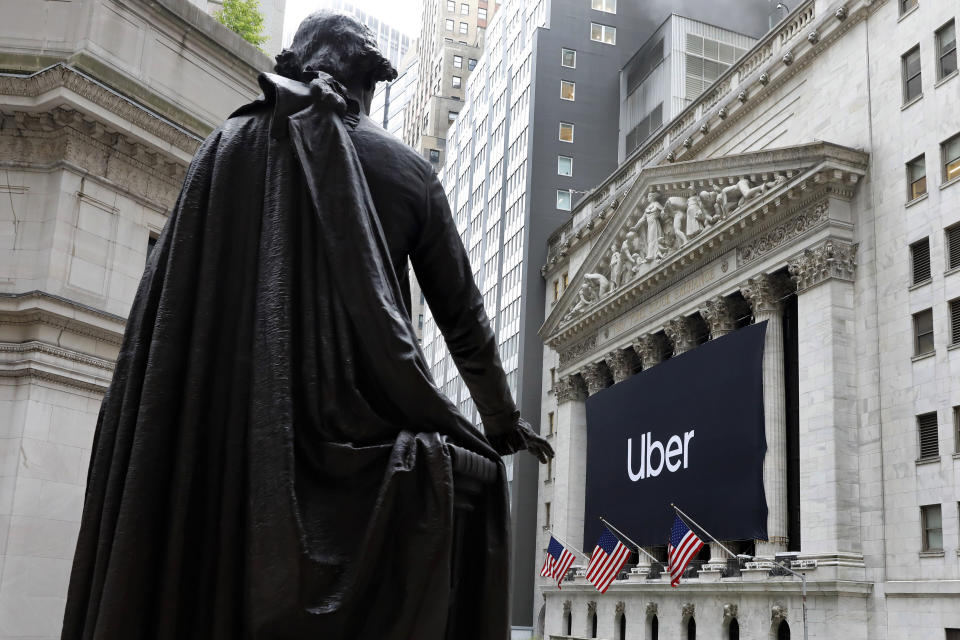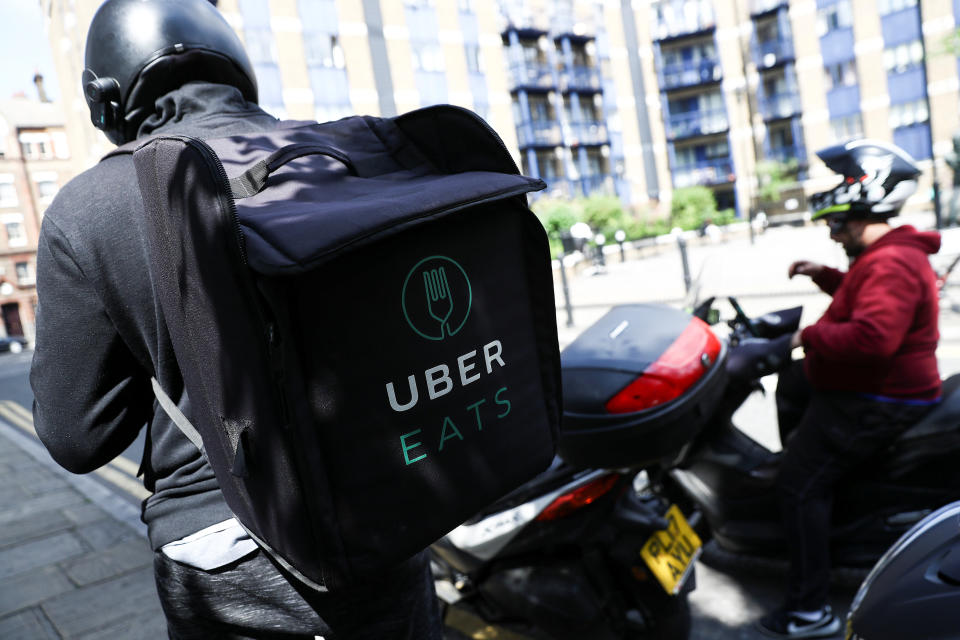Why Uber’s business model could come undone after its IPO
Howard Yu is the LEGO professor of management and innovation at IMD business school in Switzerland, and author of the book "Leap: How to Thrive in a World Where Everything Can Be Copied"
—
Nothing new can come from a situation without suffering. If any new understanding about the nature of platform companies is to materialize in 2019, it will be because of the extreme over-valuation of Uber, on full display this week.
Uber's valuation at IPO this Friday, based on its offering price, will be $82 billion. The company is raising $8.1 billion, and is expected to be the year’s biggest U.S. IPO. Only two other U.S. IPOs have ever been more valuable: Alibaba in 2014, at a value of $167 billion, and Facebook in 2012, at a value of $104 billion.
The biggest winners this time will include Jeff Bezos, whose $3 million personal investment in Uber is likely to be worth $400 million. Other well-known investors include Benchmark, whose $30 million stake is set to make around $7.9 billion, and Menlo Ventures, whose $67 million investment is expected to become about $3 billion. But the question for the public is, should we join in? What can academic research tell us?
[Read More: Uber delivers on the promise every tech company has ever made]
In explaining the dynamics of a “platform economy,” as opposed to those of a traditional economy, economists and business researchers routinely use the “network effect” as a way of describing the value of a platform. This value largely depends on the number of users on either side of the exchange. The more riders a ride-sharing platform has, for instance, the more attractive it becomes to drivers, leading even more people to use it.

And once a platform reaches a certain size, the thinking goes, it becomes too dominant to unseat. In other words, a platform economy has no room for multiple players; the market equilibrium will forever move toward a monopoly. So Google dominates search engines, Facebook rules social networks, Twitter towers over microblogging, and Netflix, YouTube, and Spotify have cornered the movie-streaming, video-sharing, and music-streaming markets, respectively.
If we follow this logic, however, there should be either Uber or Lyft, but not both. And we’ve seen that coming with Uber’s moves in international markets. It sold its China operation to Didi Chuxing in 2016, not because of political pressure from Beijing, but because of fierce competition from local players. A year later, in 2017, Uber sold its operation in Russia to Yandex. This was followed by yet another exit in March 2018, when Uber bowed to Grab by selling off its Southeast Asian operation in Cambodia, Indonesia, Malaysia, Myanmar, the Philippines, Singapore, Thailand, and Vietnam. It’s easier for Uber to achieve scale than to sustain it.
This explains, in part, why although Uber is operating in more than 700 cities around the world, 24% of the total bookings occur in just five of those—New York, Los Angeles, San Francisco, London, and Sao Paulo. Outside those core cities, Uber faces fierce local competition. Latecomers in these local markets emulate what Uber does and outdo it. Uber still had a monthly average of 91 million active users at the end of 2018, but growth had slowed from 51 percent a year earlier to 33.8 percent.
Investors often invest in money-losing businesses because they believe tech companies that begin with modest goals and creative business plans will soon follow the growth script of Amazon in realizing their own routes to infinity and beyond.
[Read More: How Uber's biggest investor is shaping the global ride-sharing market]
To knit together precisely that precious narrative for an IPO, CEO Khosrowshahi positioned Uber as the hub for disparate categories of transport. It included Uber Eats, a food-delivery service; Uber Freight, a trucking business; and Jump, a shared scooter and bike operation. Khosrowshahi equated Uber to Amazon.
But Uber has never been about building infrastructure. Amazon built not only a website and an app, but warehouses, logistic networks and I.T. systems. Uber never did. It uses two cloud computing providers: AWS and Google Cloud. Uber didn’t even develop its own maps; it spent tens of million to use Google Maps.

The paradox is this: Lots of businesses require heavy investment. Cellular phone operators and cable TV companies all have to spend billions to build their physical networks. But that investment is finite, whereas Uber is spending cash not on building physical assets, but on buying market share, pushing driver incentives and rider discounts, and advertisements. These are infinite expenditures, limited only by a company’s ability to raise money from venture capital firms and IPO. That’s how Amazon lost $2.8 billion over its first 17 quarters as a public company, while Uber lost over $4 billion in 2017 alone.
One bright spot that Uber seeks to highlight in its IPO filing is on “platform synergies,” where “each new product adds nodes to [its] network and strengthens these shared capabilities,” which in turn will “fuel multiple virtuous cycles of growth.” It claims that “Uber Eats is used by many of the same consumers who use our Ridesharing products, [and] is built on our existing technology stack.” And so in the future, Uber “can more efficiently launch other products and offerings, such as dockless e-bikes and e-scooters, by leveraging our existing network of Drivers and consumers and regional on-the-ground operations teams.”
[Read More: The biggest risks to Uber's business as it prepares for its IPO]
Such strong cycles of growth won’t be possible without an integrated data strategy. Any data scientists would agree that data sets become geometrically more valuable when you combine them. Combined data sets often reveal insights and business opportunities that could not have been imagined previously. When Google introduced Gmail, it built a data set that was largely able to duplicate a user’s identity.
Combining the two data sets prompted a huge increase in value, as future AdWords ads would have more worth for the advertiser and, by extension, for Google. The same thing happened again with Google Maps, which enabled Google to tie identity and purchase intent to location. Each time Google introduces a new service, it finds new use cases for user data by combining data sets. This is also the allure of Uber; the company can recombine data stemming from its core business and then invade an adjacent business line for growth.

Still, this business logic could come undone. Last year, Europe introduced its General Data Protection Regulation (GDPR) in an effort to thwart consumers being treated as commodities. Consumers must give their consent before a company such as Uber can start to collect personal data, and the company must explain why data is collected and how it is used. The company is not allowed to use that data for different purposes later on. There has been talk, and even a legal action started in Germany, aimed at prohibiting Facebook from integrating Messenger, Instagram and WhatsApp as it seeks to combine user data from different sources. Another German initiative proposes that dominant platforms must share bulk, anonymized data with competitors, meaning all transport firms would have access to Uber’s information about traffic patterns.
Europe would obviously have limited influence on Uber’s global strategy. But Europe remains the most profitable market outside of the U.S., a market that no tech firm can completely ignore or defy. London is currently one of the top five cities that produces the most bookings for Uber, and the U.K. is under the GDPR regardless of whether Brexit proceeds. Perhaps most problematic for Uber is that many countries around the world are emulating Europe’s position on data protection and consumer privacy.
Thus, the investment thesis inspired by the platform economy of the past—winners take all; competition is for losers—cannot hold. There might not be a tech bubble that bursts as badly as in the 90s, but the growth prospects of Uber and its competitors will diminish.
[Read More: Uber has lived through a parade of executive exits before its IPO]

